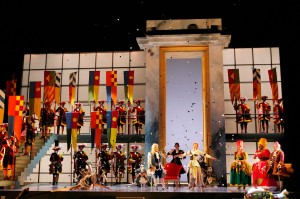Rossini’s Cinderella casts enchanting spell on LA
In Rossini’s Cinderella, the prince (with the short, somewhat stocky stature of a tenor) is most likely not the man that girls dream about. The mice (or in this case, large rats) are not cute and cuddly sidekicks. And Cinderella (or La Cenerentola, as she answers to) might never don a glass slipper or sit in a pumpkin carriage.
But, the opera’s focus on character development, rather than iconic imagery, is perhaps why the production, which opened last weekend at the LA Opera, so effortlessly seeps into your heart.
With just the right touch of madcap humor, social commentary and whimsical interpretation, this rendition of Cinderella, brought to life by director Joan Font and conductor James Conlon, dazzles as an enlightened departure from the tale you grew up with.
The story begins when the prince’s tutor, Alidoro (Nicola Ulivieri), disguised as a beggar, knocks on the home of Don Magnifico (Alessandro Corbelli). Though the two wicked stepsisters, Clorinda (Stacey Tappan) and Tisbe (Ronnita Nicole Miller), turn him away, Cinderella (Kate Lindsey) takes pity on Alidoro and gives him bread and coffee.
Touched by Cinderella’s kindness, Alidoro tells Don Ramiro (Rene Barbera) about his encounter. Intrigued, Don Ramiro decides to switch places with his valet, Dandini (Vito Priante), and judge for himself whether she might be a worthy bride.
It is clear that Priante is having fun in the role of valet-turned prince. He shines as he plays off of Barbera’s energy, and there is a gleeful lilt to his voice as he orders Don Ramiro around for a change, making him pick up his hat and follow his commands.
Priante holds court on the stage when he makes the audience laugh, but Barbera stands out through his persual of Cinderella. By taking the time to get to know her and observing her everyday life, it is easy to believe Don Ramiro when he sings that he is falling in love.
Barbera certainly knows what he is doing in this role. Though Don Ramiro is a prince, Barbera has a certain sweet, sympathetic quality about him that makes the audience root for his character to end up with Cinderella. Their romance feels like a slow burn, which is a notable task to accomplish in an opera that moves at a piano forte pace.
The rapid pace is necessary, however, for the over-the-top scale of the opera. In an effort to enhance the absurdity of courtier life, the performance carries a grandiose element to it. That is aided by the ridiculous, almost art-deco feel of the costumes. Cinderella’s stepsisters, Clorinda and Tisbe, for example, (wearing giant wigs shaded highlighter pink and sunshine yellow) are textbook examples of the absurd fashion worn in court.
Tappan and Miller play it up by flaunting their ballooning undergarments, which give the stepsisters an almost cartoonish hourglass figures.
The rats truly steal the show, though, with their large rodent costumes and even larger personalities. Cinderella’s companions are always in the background, playing with the props, sampling the food and just generally behaving as rats would. They have the audience in the palm of their hands and they know it, too. Two of the rats stay on stage after the curtain for intermission falls and pull their tails above their eyes in a pretense of modesty. But even the giant pink tails cannot disguise their glee from being in the spotlight.
The rats do not serve solely as comedic relief, however. Operas traditionally serve as commentaries on class; rats, quite possibly the lowest creature imaginable in society, are far enough removed from the inside to shine a light on the absurdity of society. With their clever eyes and lithe movements, they are the Greek chorus of this opera — always observing court life and the people who take part in it and inviting the audience to share with them in the joke.
Cinderella is the moral center of the play and because of that, her part falls a little flat. Though Lindsey plays Cinderella beautifully — her mezzo-soprano voice is strong and sympathetic throughout the performance and her acting feels genuine — the character does not have exciting costumes or rapid-fire humorous lines that make her stand out. Though it is wonderful to get to know the prince and to see what he loves about Cinderella, the character of Cinderella is never given the opportunity to learn anything herself, which is a loss.
Still, Cinderella is the glue that holds the play together. It would be so easy in an opera, with its grandiose size and scale, to get caught up in the glamor and grandeur of it all. However, Cinderella never loses her humble origins and because of this, the opera never feels too over the top. At the end, Cinderella stands alone on the stage. She still wears her dress with patches in it and sweeps the floor humbly, though she now wears a tiara. The music accompanies her until the lights finally dim, and you are left with an image of Cinderella, now a queen, but still just as humble as ever.
And there is something beautiful about that image that stays with you long after the clock strikes midnight.
